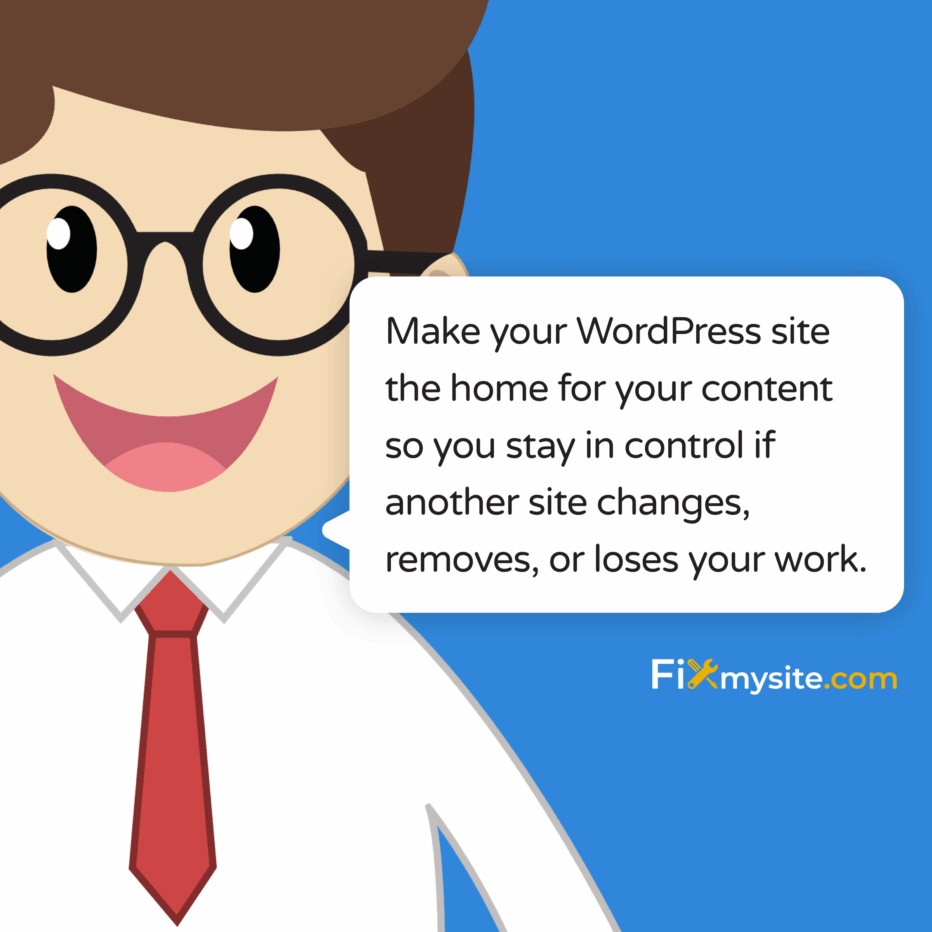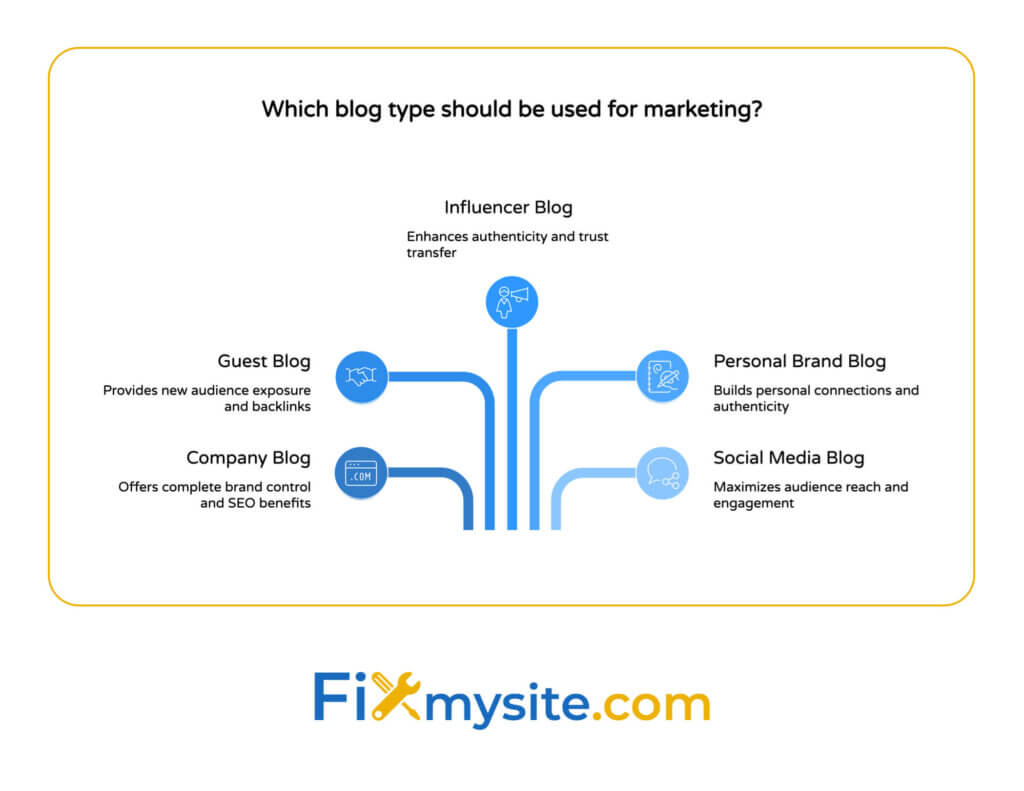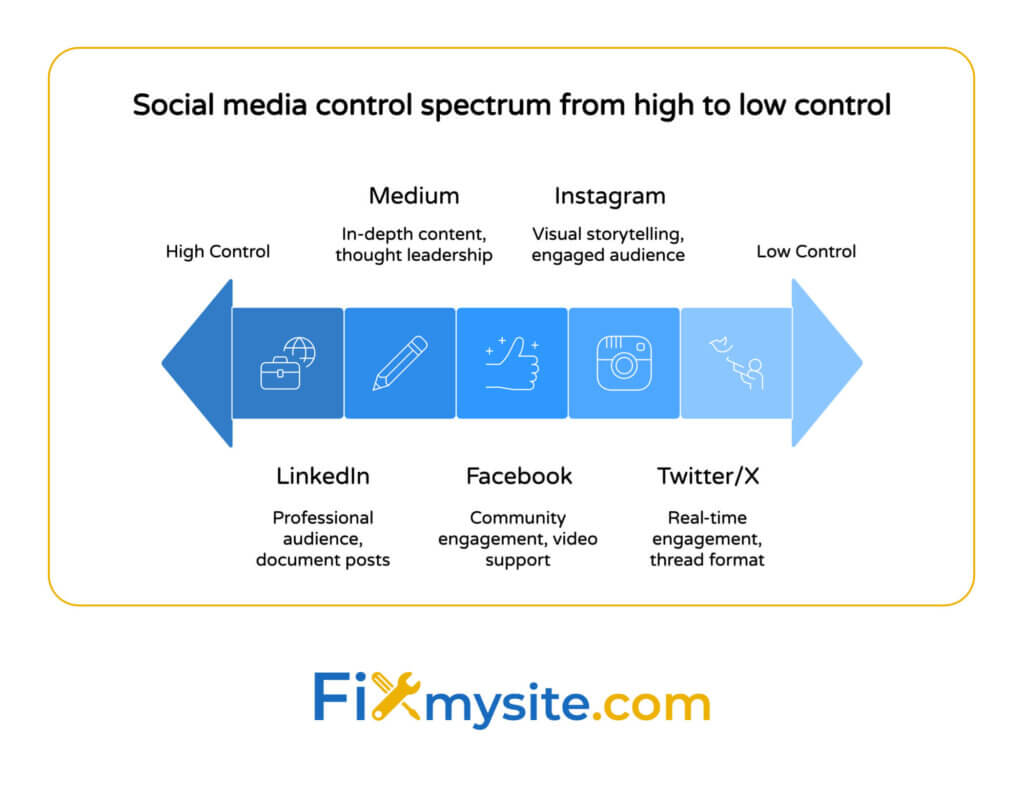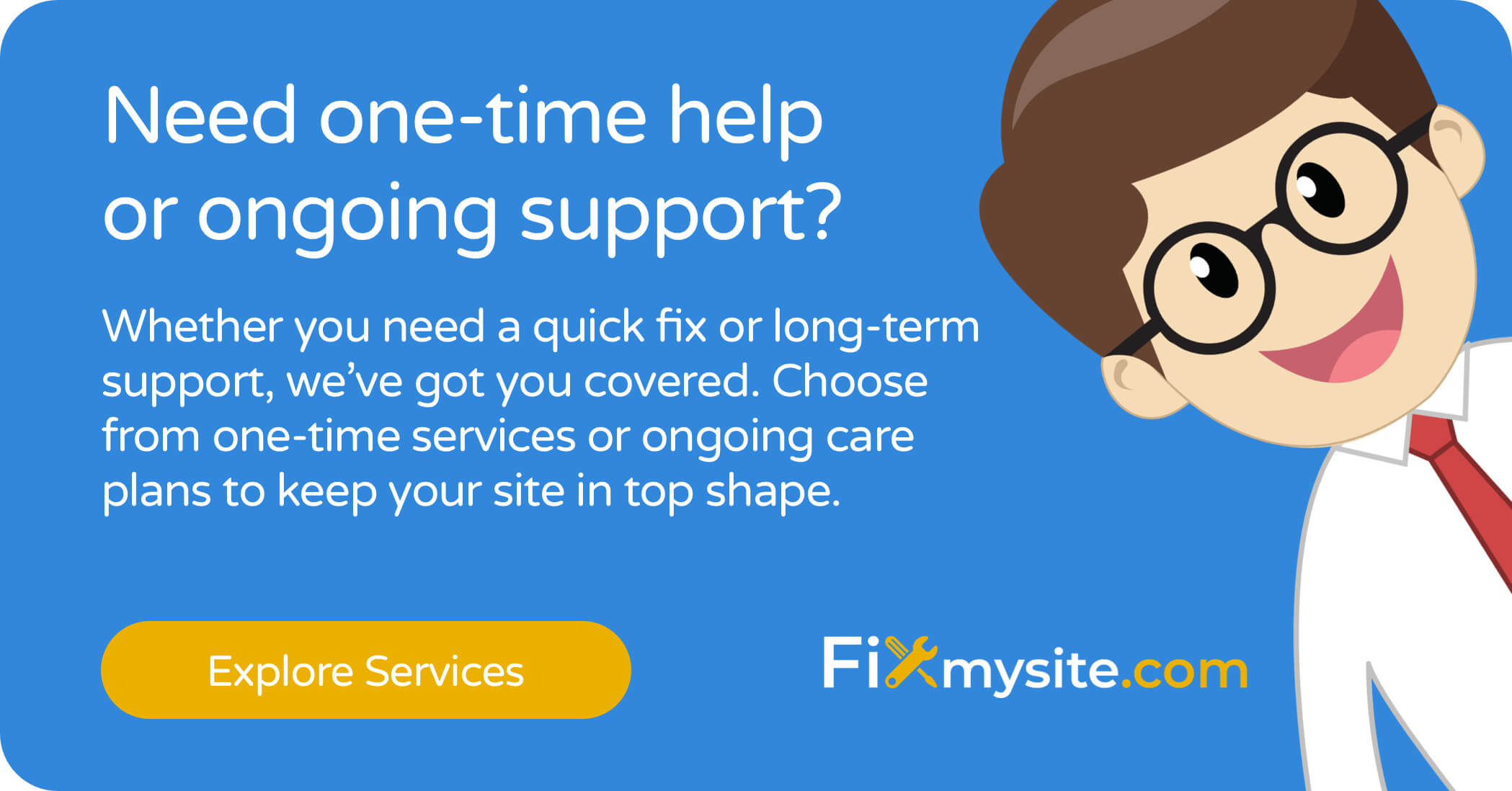
Control matters in marketing. When you manage a WordPress site or create content as part of your marketing strategy, understanding how much influence you have over different blog formats can make or break your success. Some blog types offer near-complete authority over messaging, while others leave you largely at the mercy of external factors.
For businesses investing in content marketing, knowing which blog environments provide the least control helps you set realistic expectations and develop appropriate strategies. This knowledge becomes especially valuable when allocating limited marketing resources.
In this analysis, we’ll examine the major blog types, assess control factors for each, and reveal which format consistently gives marketers the lowest level of control. We’ll also provide practical strategies to maximize your influence even in challenging blog environments.
What Are The Different Blog Types?

Before identifying which blog type offers marketers the least control, we need to define the major blog categories that most marketing strategies incorporate. Each serves different purposes and comes with unique control considerations.
Blogs exist across various platforms and ownership models. Some offer nearly complete control over content, format, and distribution, while others place significant restrictions on marketers. Understanding these differences helps you develop more effective content strategies.
Let’s examine the five primary blog types marketers regularly work with:
| Blog Type | Definition | Typical Ownership | Primary Benefits |
|---|---|---|---|
| Company Blog | Blog hosted on a company’s own website | Company owns all content and platform | Complete brand control, SEO benefits, lead generation |
| Guest Blog | Content published on another organization’s blog | Host site owns published content | New audience exposure, backlinks, authority building |
| Influencer Blog | Content created in partnership with influencers | Usually owned by the influencer | Authenticity, trust transfer, engaged audience |
| Personal Brand Blog | Blog run by an individual representing themselves | Individual owns all content | Personal connection, authenticity, direct audience relationship |
| Social Media Blog | Blog-like content published on social platforms | Platform owns infrastructure, usage rights often complex | Large audience reach, engagement tools, sharing potential |
Each blog type serves different marketing objectives. Company blogs build long-term assets and support search visibility. Guest blogs help reach new audiences. Influencer partnerships leverage established trust. Personal brand blogs create authentic connections. Social media blogs offer vast reach but with significant trade-offs.

Key Factors That Determine Marketer Control
Control in blogging isn’t binary. It exists on a spectrum influenced by multiple factors. Understanding these elements helps marketers accurately assess how much influence they truly have over their content and its performance.
Several critical factors determine your level of control across different blog types. These factors impact everything from content creation to performance measurement. The weight of each factor varies depending on your specific marketing goals and resources.
Here are the essential factors that determine marketer control:
- Content ownership rights – Who legally owns the content once published
- Editorial authority – Ability to decide what’s published and how it’s presented
- Design flexibility – Freedom to control layout, branding, and visual elements
- Publishing schedule – Control over when content goes live
- Audience data access – Visibility into who’s consuming the content and how
Content ownership forms the foundation of control. When you maintain complete ownership rights, you can repurpose, update, or remove content as needed. Without these rights, your long-term content strategy becomes vulnerable to external decisions.
Editorial authority determines how much your authentic message reaches the audience. Limited editorial control means your content might be significantly altered, potentially diluting your marketing message or brand positioning.
Let’s examine how these control factors vary across different blog types:
| Control Factor | Company Blog | Guest Blog | Influencer Blog | Social Media Blog |
|---|---|---|---|---|
| Content Ownership | Complete | Limited/None | Shared/Limited | Minimal |
| Editorial Authority | Complete | Moderate | Negotiated | Limited |
| Design Control | Complete | None | Limited | Minimal |
| Performance Data Access | Complete | Limited | Shared | Platform-controlled |
| Content Longevity Control | Complete | Limited | Negotiated | Almost none |
As the table shows, company blogs offer marketers the highest level of control across all factors. At the other end of the spectrum, social media blogs severely restrict marketer control in nearly every category.
Bloggers who regularly check Google Analytics are 3.6× more likely to achieve strong results (36%) than those who rarely or never do (10%). (Source: WPBeginner)
This statistic highlights the importance of data access and analytics in successful blogging – a control factor severely restricted in certain blog types.
Control Level Comparison Across Blog Types
Now that we’ve established the key control factors, let’s directly compare how much influence marketers have across different blog types. This analysis helps identify which format consistently offers the lowest level of marketer control.
Control varies significantly across blog formats. Each presents distinct advantages and limitations that affect your marketing effectiveness. Understanding these differences helps you set realistic expectations and develop appropriate strategies for each environment.
Company Blog Control
Company blogs provide the highest level of marketer control. You own the platform, set the editorial calendar, and maintain complete authority over content, design, and user data. This control extends to technical aspects through tools like WordPress cache plugins that optimize performance.
With a company blog, you can implement specific technical optimizations that support your marketing goals. You control the user experience from start to finish, including load speed, mobile responsiveness, and conversion paths.
Key advantages include:
- Full ownership of content and intellectual property
- Complete control over publishing schedule and updates
- Unrestricted access to audience data and behaviors
- Ability to implement technical SEO optimizations
- Full integration with marketing tools and analytics
The primary limitation of company blogs is reach. Building an audience requires significant time and consistent effort, unlike platforms with built-in distribution mechanisms.
Guest Blog Control
Guest blogs offer marketers moderate control. While you typically create the initial content, the host publication maintains editorial authority and design control. Your influence largely ends after submission, though some relationships allow for collaborative editing.
Once published, you generally can’t update or modify guest content without the host’s approval. This creates limitations for maintaining content accuracy over time or adapting to changing marketing messages.
According to research, 38% of bloggers using multiple editors report strong results, outperforming those with informal editing (22%). (Source: Wix)
This statistic suggests that despite reduced control, the editorial oversight in guest blogging environments may actually improve content quality and performance in some cases.
Influencer Blog Control
Influencer blogs provide limited marketer control. While you can outline key messages and goals, the influencer maintains significant creative and editorial freedom. This arrangement preserves authenticity but reduces direct marketer control over the final content.
The effectiveness of influencer blogs depends heavily on relationship quality. The stronger your partnership, the more influence you’ll have over content direction while still benefiting from the influencer’s authentic voice and established audience trust.
Control challenges include:
- Limited input on content tone and style
- Restricted access to performance data
- Potential message dilution to match influencer voice
- Unpredictable publishing schedules
Despite these challenges, 38% of marketers leveraging influencers for 50-90% of their work report successful outcomes, versus just 14% who avoid influencer partnerships. (Source: Wix)
Social Media Blog Control
Social media blogs offer marketers the lowest level of control among all blog types. These platforms severely restrict content formatting, limit analytics access, and can change visibility algorithms without notice. Your content exists entirely within their ecosystem, subject to their rules and technical limitations.
Platform policies can change unexpectedly, affecting content visibility, format options, and even account status. Unlike owned media, social platforms maintain the right to remove content or restrict access based on their evolving guidelines.
| Blog Type | Overall Control Level | Key Control Limitations |
|---|---|---|
| Company Blog | Very High (80-100%) | Audience building challenges |
| Guest Blog | Moderate (40-60%) | Limited post-publication updating, host editorial control |
| Influencer Blog | Limited (30-50%) | Creative direction determined by influencer, negotiated messaging |
| Social Media Blog | Very Low (10-30%) | Algorithm dependency, format restrictions, content ownership issues |
The data clearly shows that social media blogs consistently provide marketers with the lowest level of control among all blog types. The restrictions span all critical control factors, from content ownership to distribution visibility.
Social Media Blogs: The Lowest Control Environment

After analyzing control factors across blog types, social media blogs emerge as the environment where marketers have the least control. Let’s examine why these platforms create such significant control limitations for marketing teams.
Social media blogs include long-form content published directly on platforms like LinkedIn, Facebook, Medium, or Instagram. While these platforms offer massive audience potential, they severely restrict marketer control in several critical ways.
Nearly all bloggers (99%+) use social media to promote content, while two-thirds utilize SEO and email marketing. (Source: Orbit Media)
This statistic highlights the widespread use of social platforms despite their control limitations, suggesting that marketers accept reduced control in exchange for distribution benefits.
Why Marketers Have Minimal Control on Social Platforms
Social platforms create unique control challenges that exceed those of other blog types. These platforms are designed primarily to serve their own business models rather than marketer needs, resulting in systematic control limitations.
Understanding these specific restrictions helps you develop appropriate strategies for social media blogs while maintaining realistic expectations about your influence over content performance.
| Control Limitation | Impact on Marketers | Comparative Severity |
|---|---|---|
| Algorithm-Determined Visibility | Content reach depends on platform algorithms that change without notice | Severe |
| Format Restrictions | Limited formatting options, restricted media integration | High |
| Content Ownership Ambiguity | Platforms often claim usage rights to posted content | Severe |
| Limited Performance Data | Restricted analytics access compared to owned platforms | Moderate |
| Content Permanence Risk | Platforms can remove content or change access without notice | High |
The most significant control limitation is algorithm dependency. Unlike owned blogs where content visibility remains stable, social media visibility fluctuates based on proprietary algorithms. Your content’s reach depends entirely on the platform’s changing distribution rules.
Over 70% of companies believe blogging has become more effective for generating leads, highlighting the value of higher-control blog environments for business goals. (Source: Databox)
Unique Challenges of Social Media Blogs
Social media blogs present specific challenges that reduce marketer control far below other blog types. These limitations affect everything from content creation to performance measurement, creating a uniquely restrictive environment.
Understanding these specific challenges helps you develop appropriate expectations and strategies when using social media blogs in your marketing mix. While these platforms offer valuable benefits, their control limitations create significant hurdles.
Algorithm Dependency
Social platforms use complex algorithms to determine content visibility. These algorithms change frequently, often without notice, directly affecting how many people see your content. Unlike owned blogs where visibility remains consistent, social media reach can fluctuate dramatically based on algorithmic changes.
This dependency creates fundamental uncertainty about content performance. A post that reaches thousands today might only reach hundreds tomorrow, despite identical quality and relevance. This unpredictability severely limits your ability to plan and execute consistent content strategies.
Format and Length Restrictions
Social platforms impose strict limitations on content format, structure, and length. These restrictions vary by platform but consistently limit marketer control over how content appears to the audience. Your carefully designed content must conform to platform limitations rather than marketing objectives.
Basic formatting options available on owned blogs, such as custom HTML, interactive elements, or specialized layouts, are typically unavailable or severely restricted on social platforms. This limits your ability to create truly distinctive content experiences.
Content Ownership Ambiguity
When publishing on social platforms, content ownership becomes ambiguous. While you create the content, platforms typically claim extensive usage rights through their terms of service. This limits your control over how your content might be used in the future.
This ambiguity creates risk for valuable marketing assets. Content that performs exceptionally well might be leveraged by the platform in ways that don’t align with your marketing objectives or brand positioning.
Data Accessibility Limitations
Social platforms restrict access to detailed performance data compared to owned blogs. While basic metrics like views, likes, and shares are typically available, deeper insights into audience behavior remain limited or completely inaccessible.
This data limitation affects your ability to optimize content strategies. Without comprehensive analytics, identifying what truly drives engagement and conversion becomes significantly more challenging compared to owned blog environments.
46% of consumers consider bloggers’ opinions when making decisions, demonstrating the influence potential despite control limitations. (Source: Diggity Marketing)

Strategies to Maximize Control in Low-Control Environments
While social media blogs offer marketers the lowest control level, you can implement specific strategies to maximize your influence within these environments. These approaches help mitigate control limitations while leveraging the reach benefits these platforms provide.
The key to success lies in working within platform constraints while maintaining content integrity. These strategies won’t provide the same control level as owned blogs, but they can significantly improve your effectiveness in low-control environments.
Cross-Platform Content Protection
Protect your valuable content by publishing first on high-control platforms before sharing on social media. This approach establishes clear ownership while still leveraging social distribution. Your owned blog becomes the content home, with social platforms serving as distribution channels.
How can you protect your WordPress site from hackers when sharing content across multiple platforms? Start by establishing clear ownership through timestamped publication on your owned site before distributing to social channels.
This strategy creates several advantages:
- Establishes clear content ownership through original publication
- Creates canonical sources that search engines recognize
- Builds audience pathways back to your owned properties
- Maintains content integrity regardless of platform changes
For WordPress site owners, this approach has the added benefit of driving traffic to your owned platform where you have complete control over the user experience and conversion opportunities.
Platform-Specific Content Adaptation
Rather than fighting platform limitations, adapt your content strategy to work within each environment’s specific constraints. This means creating content variations optimized for each platform’s unique characteristics rather than trying to force identical content across all channels.
This adaptation strategy requires understanding each platform’s specific algorithm preferences, format requirements, and audience expectations. Content that performs well on LinkedIn often differs significantly from successful content on Instagram or Medium.
| Social Platform | Content Optimization Approach | Control Enhancement Strategy |
|---|---|---|
| Professional insights, industry analysis, career development | Use document posts for more formatting control, limit external links | |
| Medium | In-depth analysis, personal stories, thought leadership | Import from WordPress to establish canonical ownership, customize story presentation |
| Community-focused, conversational, video-friendly | Use Notes feature for longer content, create platform-exclusive elements | |
| Visual storytelling, carousel posts for sequence | Use carefully designed image text, consistent visual branding | |
| Twitter/X | Concise insights, thread format for longer content | Create custom visuals with key messages, use strategic thread structure |
Understanding WordPress security fundamentals helps you make better decisions about how to safely distribute content from your secure home base to various social platforms where you have less control.
Audience Ownership Development
Develop strategies to convert social media audiences into owned relationship channels like email lists or community platforms. This approach reduces dependency on low-control environments by building direct audience connections.
Even with limited control on social platforms, you can implement specific tactics to build audience ownership:
- Include clear calls-to-action directing users to owned properties
- Offer exclusive content available only through direct channels
- Use lead magnets specifically designed for social audience conversion
- Create platform-appropriate conversion paths that work within constraints
This strategy recognizes that while social platforms offer reach, genuine audience relationships provide long-term marketing value. By systematically moving people from social platforms to owned channels, you gradually reduce dependency on low-control environments.
Buyers who read blog content are more likely to make purchase decisions, with 34% making unplanned purchases after reading content. (Source: Diggity Marketing)
Multi-Platform Distribution Strategy
Distribute content across multiple platforms to reduce dependency on any single low-control environment. This approach creates resilience against platform changes while maximizing potential reach. If one platform changes algorithms or policies, your content remains visible elsewhere.
A balanced distribution strategy might include:
- Primary publication on your WordPress site for maximum control
- Secondary distribution across multiple social platforms
- Strategic partnerships with higher-control guest blog opportunities
- Email distribution to owned audience lists
- Community platform sharing in relevant groups
This multi-channel approach ensures that algorithm changes or platform restrictions on any single channel won’t devastate your entire content strategy. It creates strategic redundancy that preserves content visibility despite control limitations.
With properly optimized WordPress sites loading up to 200% faster, your owned blog provides a superior user experience compared to the often slower-loading social platforms. This performance advantage helps drive conversion from social channels to your owned properties.
Conclusion: Balancing Control and Reach
After examining control factors across various blog types, social media blogs clearly emerge as the environment where marketers have the lowest level of control. The combination of algorithm dependency, format restrictions, ownership ambiguity, and data limitations creates a uniquely challenging environment for marketing teams.
Despite these control limitations, social platforms continue to play a valuable role in content marketing strategies due to their unmatched reach potential. The key to success lies in strategically balancing high-control and low-control environments rather than relying exclusively on either approach.
For WordPress site owners and marketers, this analysis suggests several important considerations:
- Maintain your WordPress site as your content home base where you have maximum control
- Use social media blogs strategically for distribution and audience building
- Implement cross-platform protection strategies to establish clear content ownership
- Develop audience migration pathways from low-control to high-control environments
- Create platform-specific content adaptations that work within each environment’s constraints
By understanding the control limitations of each blog type, particularly social media blogs, you can develop realistic expectations and appropriate strategies. This balanced approach allows you to leverage the reach benefits of low-control environments while maintaining the integrity and long-term value of your content marketing efforts.
Need help optimizing your WordPress site to serve as a high-control content hub? Our WordPress support team can help you create a secure, high-performance foundation for your content strategy.



